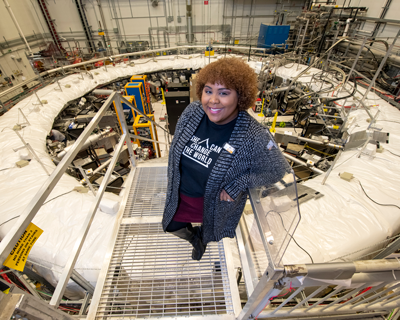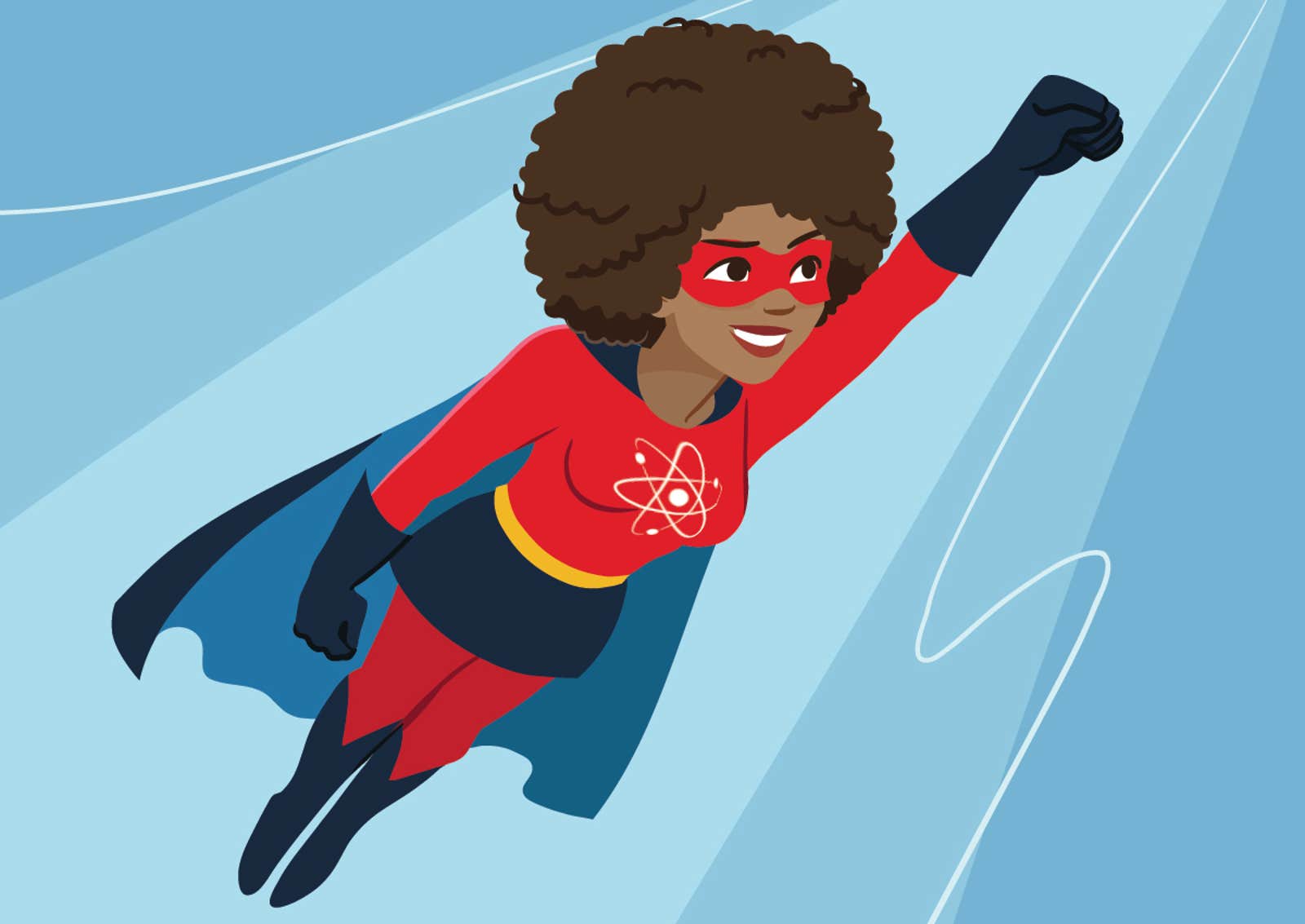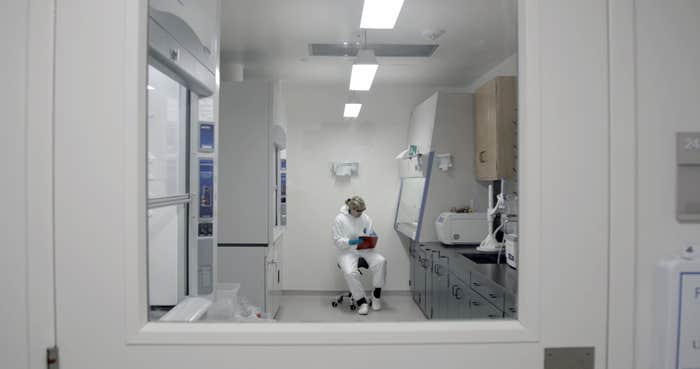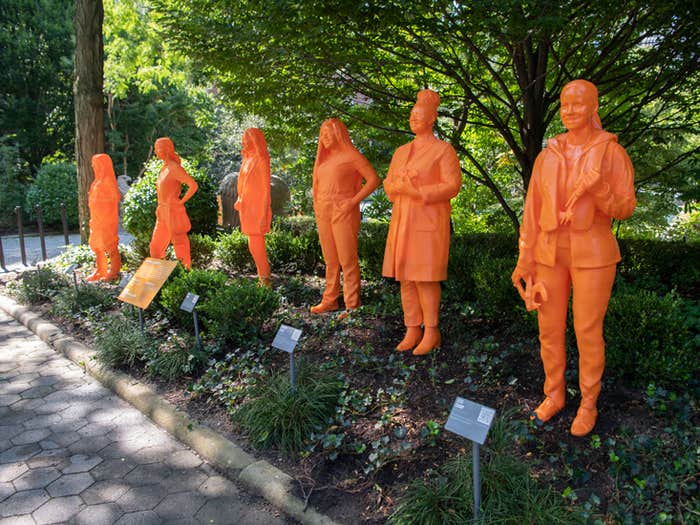The physics of superheroes is more than a fun
exercise in the world of Jessica Esquivel. A particle physicist in the Muon Department of Fermi
National Accelerator Laboratory, Esquivel works at what she calls “the bleeding edge” of the known
universe. In the world of physics, Esquivel is
frequently the “only.” The only woman, the
only Mexican, the only black person, and the only lesbian.
Recently she brought
her experience to Wakandacon, the comic book conference
based on the African-centric world
of Black Panther. Making her own costume, Esquivel cosplayed as Shuri, the
technological genius who designs weaponry
for her brother, Black Panther. Esquivel also
organized a panel of black scientists and was on
hand to answer questions at Fermilab’s booth at the
conference. To many women of color interested in the hard sciences, Esquivel herself is a superhero.
You knew you wanted to be an astrophysicist from a
young age. How did you get the idea?
My aunt babysat for me when I was really young and
we watched a lot of sci-fi shows on television. One
featured an astronaut in space fighting aliens while an
astrophysicist back at NASA directed him to press this
or that button, go right, go left—it was very dramatic.
I thought the astrophysicist was the actual hero in the
story, so I walked around saying I was going to be one.
I grew up in Texas, and when I was about 12 my family
took me to NASA in Houston. They sprang for the VIP
tour, but I was bored! There was no astronaut floating
in space on the screen, and everyone was typing on
their keyboards and drinking coffee.
On that same trip we saw astronauts and a space
shuttle in a big pool, simulating the absence of gravity in space. The scientists working on this were engineers, so I changed my ambition and said, “okay, I’ll be
an engineer and work on that.”
How did your path unfold?
My family helped me stay the course. I did lots of science camps and went to The Science Academy of South
Texas. I loved reading and English, but math and science were like puzzles, and though they didn’t come
easily to me I liked figuring them out. I went to St.
Mary’s University in San Antonio, thinking I would
pursue electrical engineering. That’s where I took my
first physics class—physics for engineers. I fell in love
with it.
The professor happened to be Dr. Richard Cardenas, an amazing person who has won national recognition for STEM [science, technology, engineering, and
math] and community mentoring. He encouraged me
to go into physics. My mom said, “What do physicists
do? I can’t pay for you to be a student for the rest of
your life.” In her eyes, engineers had job security. I
went back to Dr. Cardenas and he said, “Okay, do both
of them!” He was nonchalant, like no problem, I was
going to be able to do these two massive majors. My
mom agreed, as long as I finished in four years.
So I had my mom on board, and this amazing mentor, but I had to convince the engineering department.
They had never seen anyone do it before, and here is
a black, Mexican woman who wants to do it. I had to
take 18-21 hours every semester until I graduated. Dr.
Cardenas really rallied for me. He is an amazing mentor, and I definitely needed people in my corner.
This project has the
potential to revise
understanding of the
building blocks of the universe.
Did engineering continue to hold interest for you?
For me, physics presents the possibility of studying
what no one has seen before. Engineering essentially
applies knowledge and helps to create something new
with it. Particle physics, for example, is about studying the smallest building blocks of nature. We think
we know most of the building blocks necessary for the
world around us, but there are holes in that knowledge. Physics brings us to the bleeding edge of what we
know about the universe, and then engineers invent
detectors to try to study and fill these holes in what we
know. Physics and engineering are both amazing, but
the unknown has a bigger draw for me.
Was your mother right about physics?
It has practical applications! Through internships I got
to dip my toes into different types of physics. I worked part-time throughout my college career at the Air
Force base, first in San Antonio and then in Houston. I
worked in optical radiation physics and particle physics. Optical radiation is essentially putting lasers on eye
tissue and seeing how long that can go on before it is
damaging. I took a gap year and worked there full-time.
A gap year? Why?
My wife was a year behind me, and I wasn’t ready to do
long distance. So I waited and we both moved to New
York for graduate work at the same time. That was
2012. I went to Syracuse University and she did a master’s in psychology and religion at Union Theological
Seminary in Manhattan. On weekends we pretty much
switched off who was going where. We’re both from
small towns in Texas, and I always wanted city living,
so I liked to “vacation” in the city.

You live in Chicago now. How do New York and Texas
compare?
Everybody says the south is very red, full of racism,
but both of us experienced microaggressions when we moved up north. It was interesting to be going through
very rigorous schooling and dealing with microaggressions at the grocery store. I processed feelings of otherness by finding a supportive study group within the
cohort at school. I also took a unique route to finding
people I felt comfortable with—I worked part-time in
a retail clothing store. It was an all-female group, many
of us women of color, and that helped tremendously
with feelings of isolation, otherness, and not-belonging. And I really enjoy plus-size fashion!
Chicago is better. It’s more diverse here. I only
applied to post docs at Fermilab because they put
money where their mouth is when it comes to diversity inclusion. But I did have to switch from studying
neutrinos in grad school to studying muons.
Neutrinos and muons. Sounds like we’re back in that
sci-fi television show you used to watch!
Both are subatomic particles. A muon is the heavier
brother of an electron. An electron is another sub-atomic particle, and we know about it because it’s
what goes around the nucleus of an atom. When you have moving electrons you get current—the electricity that powers everything around us. A muon is
heavier, and after 2.2 microseconds it decays into an
electron. To study a muon, we put millions and millions of them into a 50-foot diameter magnetic ring,
where they dance like a spinning top. Studying the
choreography of the muon we can probe into undiscovered physics.
You work on the Muon g-2 Experiment. Can you explain
it?
Muon g-2 has the potential to revise out understanding of
the building blocks of the universe. We particle physicists collate our knowledge of these building blocks
into the theory called the Standard Model. The Muon g-2 Experiment has the potential to lift up the veil of
the universe and point us toward its secrets.
When I started working on this experiment, I
didn’t grasp what the scientists were doing, and I
thought they were just adding a few decimal points
(of precision) to an experimental measurement they
had done before. But then I realized that the more
precise the measurement, the more exotic the physics we can probe.
This work has implications for revising how we
understand the Standard Model of particle physics. We
know the building blocks that make up atoms, which
then make up everything else around us. Quarks make
up the neutrons and protons inside the nucleus, and
the electron swirls around it. These building blocks are
in the first generation of matter. When you look at the
Standard Model, there are two more generations, and
we don’t understand why, or if there are more.
If you look at the fundamental forces in the Standard Model, “the weak force” is how the neutrinos communicate with what’s around them, and “the
strong force” keeps the nucleus bound. These forces
are carried by particles—W and Z bosons for the weak
force and the gluon for the strong force. One of the
fundamental forces not accounted for in the Standard
Model is gravity, which we know is all around us. But
for some reason, based on what we know now, no such
theory for a quantum gravitational force has worked
and no gravitational force-carrying particle (coined
gravitation) has been discovered yet.
Physics presents the possibility of studying what no one has
seen before.
What does it take to explore fundamental forces?
We test all of this with particle physics detectors and
accelerators. All these weird, wonky theories—we
know we’re missing something and the closer we get to
answering one question, many more questions pop up.
Fermilab is building the next generation of detectors.
Among the questions we’re trying to answer, finding
out if there’s a fourth neutrino messing about is high
on our list these days.
Virtual particles pop in and out of existence in a
vacuum. We know which ones are supposed to pop
in and when, and that this will change the choreography of the muons, which spin like a spinning top
in a magnetic field. When we measure this spinning,
or precession, at very high precision, we can see if
the muons change in an unexpected way. If that happens, it means a particle we don’t know about has
just appeared, just come into the vacuum. It’s pretty
awesome.
You mentioned that Fermilab is committed to diversity.
Fermi is walking the walk. If we’re going to change
the face of STEM, we need people like me to communicate science effectively. Fermilab put me through classes on science communications, and
they encourage me to meet with students and teachers to tell them about the work I do. Most recently I
had this hair-brained idea that Fermi should partner
with Wakandacon. That’s the comic book convention based on the fictional African country in the
comic book and film Black Panther. Wakondacon is
stocked in Afrofuturism. It’s for black people, created
by black people, and a lot of Chicago-based writers,
artists, and business owners come together there and
share their art. The Black Panther film is also steeped
in STEM.
The first Wacandacon was two years ago. I reached
out to the creators and asked if I could give a talk there
on what it’s like to be a physicist. My talk was well
received, but for me it was more than that—it was soul-filling to see all these black people with all these interests like mine, in science and physics. The community
they created with this was so awesome.
How do you talk about your experience as a black
woman in the world of physics?
I’m always forthright when I talk about the issues that
black women have to face in our field. There are only
about 150 black women with a Ph.D. in physics—and
there are about 22,000 men, mostly white. When I
give a keynote presentation, I have a slide dedicated to
those numbers.
There’s still this really bad idea out there that men’s
brains are better than women’s, which is absurd. The
harder the sciences, the more you have to “use your
brain,” and the more masculine the career. Then there’s
this compounding nature of being part of an underrepresented group, of many underrepresented groups.
I focus on intersectional diversity and inclusion and
make sure I’m not using statements like “women and
minorities” or losing sight of
lesbian women with particular issues.
What advice would you give to girls interested in
physics?
I tell girls interested in STEM or physics: The physics
are not the only thing that’s going to be hard going on
this path. But there are women that look like you who
have done it before. One hundred and fifty women.
There’s hope. And we need you. We think differently.
We’ve gone through different stuff and we have grit.
I’m still in shock that Lyda Hill was able to really
carry off the “IF/THEN” ambassadorship—words are
hard to come by. They chose 125 women in STEM to
help inspire the next generation of STEM pioneers. I
kept thinking, well this is totally going to work, because
I’m so inspired right now! First the fact that I could see
so many black women in one place was so awesome
to see. Then there was this ripple effect. The conference was for women and put on by women—they were
at the helm, in the driver’s seat. The photographers
were women. We could all really lean into the fact that
women can lead.
Lead image compiled by Tasnuva Elahi, from an illustration by Vector FX / Shutterstock
This article was produced with the support of the Lyda Hill Philanthropies IF/THEN initiative and the American Geosciences Institute.

























